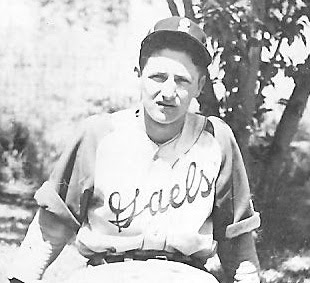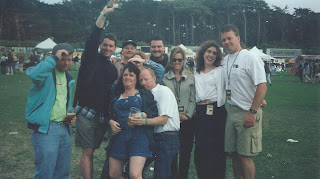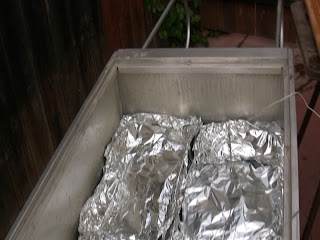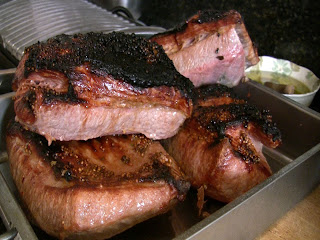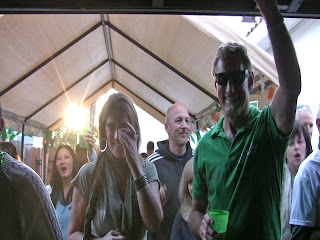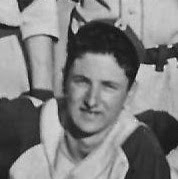 |
| Jim McNamara |
This is the eulogy regarding his baseball career.
Every love affair has a beginning, and for the McNamara Family, a love affair with baseball began on July 4th 1918 just outside the small French town of Cantigny. Europe was into its fourth year of bloodshed and the arrival of the American Army brought hope that the war to end all wars would soon be over. The Americans saw their first action in late May, when they were ordered to take and hold the strategic town of Cantigny. After several weeks of nightmarish casualties brought on by shells filled with shrapnel and mustard gas, the Americans were victorious, and the German Army began a slow, but stubborn retreat back to their homeland.
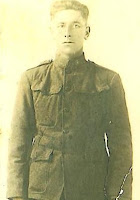 |
| John McNamara, 1918 |
An exhausted American Army was treated to a special Independence Day party with all of the trappings of home. There was to be a BBQ, followed by a concert, and then the best entertainment possible: a baseball game. However, the night before, several German planes flew over and dropped bombs all around the American camp. No one was injured, but the baseball field was now dented by bomb craters.
Attached to the 1st Army was the 1st Division of Engineers. These were the men who would go into “No Man’s Land” at night with wire cutters and shovels always under heavy fire. They would cut wire and dig trenches enabling the infantry to advance the next day. They had been crucial in the capture of Cantigny. John McNamara, who had emigrated from Ireland just three years previous, was a proud member of the 1st Engineers.
On a glorious Fourth of July Day, with thousands of French wild flowers blooming over a battle scared earth, John McNamara and his fellow 1st Engineers carried out an important order from their commanding officer: repair that field! It didn’t take long to fill in the holes, and by game time the field looked as immaculate as that new stadium in Boston called Fenway Park.
John McNamara was never a ball player, but he understood that being an American meant knowing and understanding the National Pastime. After the war, he moved back to Sacramento, California, married a pretty Irish American redhead, and raised two daughters and three sons. In a story written for the Sacramento Union back in 1983, the writer waxed perhaps just a bit poetically:
 |
| Frank, Jim, and John McNamara |
Once upon a time there were three brothers who were given baseball gloves for their first communion . They loved the game. The oldest was a shortstop the youngest a center fielder, and the middle brother eagerly donned the catcher’s tools of ignorance. Their mother used to pack a picnic lunch, reserve a baseball diamond, and take the whole neighborhood gang to the park a day of fun and games.
Although John McNamara died when his family was very young, his son Jim recalled that he would occasionaly see him standing alone in the outfield, watching the game, after taking the bus from work to Land Park. But a few minutes later, Jim would look back and he would be gone.
 |
| Slick fielding CB shortstop |
Jim's early baseball career was buttressed by three baseball playing uncles, who also played in the 1920's at a small catholic institution in Sacramento called Christian Brothers. Playing for Christian Brothers was the most important thing in the world for a young ball player in Sacramento.
Storied names like Joe Marty, Wally Westlake, and of course the Knezovich brothers played there. Jim would get a chance to join these legends when he made the varsity team in 1946. There have been a lot of great teams at CB, but I would match the 1946 team against any of them. They were a perfect 14 and 0 and crowned City Champions. Jim’s phenomenal defense steadied the team. While team mates and dear friends Mel Knezovich, Gil Urbano, and Ronnie King powered their way to the All City Team. Gil Urbano actually hit .625 for the season. While Mel Knezovich and Ronnie King turned into an unbeatable battery.
 |
| 1946 undefeated CB Ball Team |
In 1947, Brothers finished the season 12 and 4, but once again won the City Championship. Jim was never a great hitter, but his leadership and fielding was so respected that he made the All City Team.
 |
| The All City Class of 1947 |
Jim’s talent was not just confined to Sacramento, scouts began to follow him and in 1948 he was signed by the New York Giants and sent to their minor league affiliate in Anaheim and later San Bernadino. On the eve of his departure to begin his professional baseball career, Jim was given a brand new glove by some supportive friends in the neighborhood. The glove was made in Japan. On his arrival at spring training the next day, Jim’s manager, a former Marine who had served on Iwo Jima, took one look at the glove, grabbed it, and threw it in the garbage. Jim’s first day was also complicated by the fact that he had been to the lake the day before with his new team mates and was wickedly sunburned. Jim hit .217 that year, but was an immediate sensation at shortstop.
The following year for San Bernadino, Jim’ new team mate was a young power hitter named Gene Petralli. And, of course there would be more Petrallis in the future.
| San Bernadino in 1948 |
In 1950, Jim moved to the Pioneer League, where he led off and played shortstop for the Idaho Falls Russets. According to the team program, Jim was voted the best shortstop in the history of the franchise. He had a cannon for an arm, quick feet, and soft hands, all the ingredients of a great shortstop.
Jim’s last year in pro ball was in 1953 for the Yakima Bears in the Western International League. He had been beaned several times in those rough and tumble days before helmets, and the grind was beginning to wear on him. He retired at the age of 25, moved back to Sacramento, married pretty Millie Petralli, and began a 35 year career as an administrator in the Sacramento County Court System.
However, baseball would remain a major focus in his life. He played bush baseball for years up and down the Sacramento Valley, getting paid under the table handsomely by teams in Chico and Colusa, to name just a few. With his brothers John and Frank, he helped Julius' Winter League team win three championships. He coached and lovingly watched his son Tom’s career, followed daughter Patti's cheer leading years, and then his six grand kids. He never missed a game. He even learned to like or maybe tolerate wrestling and rugby.
Jimmy and Millie would often attend spring training in Arizona. One year, after watching his brother John's California Angels beat Billy Martin's Oakland A's, he was asked by John to join him in the press tent for a beer. Jim replied that he'd better not because he promised to take Millie shopping.
"Come on, one beer!" protested John.
"Ok, one beer, but a quick one" agreed Jim.
Entering the press lounge, they sat down next to a dour Martin, already into his second whiskey. The two brothers chatted while Martin stewed. Jim took his last sip and said that he had to go, when John tried to talk him into one more, Jim said: "If I don't leave right now Millie is going to kick my ass."
Martin wheeled and glared at Jimmy and growled: "I'm going to kick your ass? You bet I can kick your ass!" To which John replied, "He said Millie not Billy!"
Jimmy and Millie would often attend spring training in Arizona. One year, after watching his brother John's California Angels beat Billy Martin's Oakland A's, he was asked by John to join him in the press tent for a beer. Jim replied that he'd better not because he promised to take Millie shopping.
"Come on, one beer!" protested John.
"Ok, one beer, but a quick one" agreed Jim.
Entering the press lounge, they sat down next to a dour Martin, already into his second whiskey. The two brothers chatted while Martin stewed. Jim took his last sip and said that he had to go, when John tried to talk him into one more, Jim said: "If I don't leave right now Millie is going to kick my ass."
Martin wheeled and glared at Jimmy and growled: "I'm going to kick your ass? You bet I can kick your ass!" To which John replied, "He said Millie not Billy!"
 |
| Charley O and Johnny Mac |
 |
| Frank, Jim, and John McNamara |
| Jim McNamara |
Finally, Jim had one more gift to give baseball. A committee was formed to chronicle the long and storied history of Christian Brothers High School, and Jim was asked to write about baseball. For two years he researched and wrote what accounts to a 70 page book.
I had the pleasure of assisting him towards the end. Now, for as long as Christian Brothers stands, people will be able to read about those wonderful days where the quality of baseball played was equal to the quality of men who played it. And it will be many a day, before we see a ball player and a man the quality of Jim McNamara.
I had the pleasure of assisting him towards the end. Now, for as long as Christian Brothers stands, people will be able to read about those wonderful days where the quality of baseball played was equal to the quality of men who played it. And it will be many a day, before we see a ball player and a man the quality of Jim McNamara.


